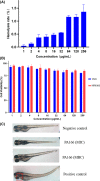Antibacterial activity and cytotoxicity of a novel bacteriocin isolated from Pseudomonas sp. strain 166
- PMID: 35849816
- PMCID: PMC9437881
- DOI: 10.1111/1751-7915.14096
Antibacterial activity and cytotoxicity of a novel bacteriocin isolated from Pseudomonas sp. strain 166
Abstract
Pseudomonas sp. strain 166 was isolated from soil samples from Changbai Mountains. A novel bacteriocin PA166 from Pseudomonas sp. 166 was purified using ammonium sulfate, dextran gel chromatography column and Q-Sepharose column chromatography successively. The molecular mass of bacteriocin PA166 was found to be 49.38 kDa by SDS-PAGE and liquid chromatography-mass spectrometry (MS)/MS. Bacteriocin PA166 showed stability at a wide range of pH (2-10), and thermal stability (40, 60, 80 and 100°C). The bacteriocin PA166 antimicrobial activity was slightly inhibited by Ca2+ , K+ and Mg2+ . The minimum bactericidal concentrations of bacteriocin PA166 against five Pasteurella multocida strains ranged from 2 to 8 μg ml-1 . Bacteriocin PA166 showed low cytotoxicity and a higher treatment index (TI = 82.51). Fluorescence spectroscopy indicated that bacteriocin PA166 destroyed the cell membrane to exert antimicrobial activity. In summary, bacteriocin PA166 had strong antibacterial activity, high TI and low toxicity, and hence could serve as a potential clinical therapeutic drug.
© 2022 The Authors. Microbial Biotechnology published by Society for Applied Microbiology and John Wiley & Sons Ltd.
Conflict of interest statement
All authors have no conflicts of interest.
Figures






Similar articles
-
Antibacterial Activity and Cytotoxicity of the Novel Bacteriocin Pkmh.Int J Mol Sci. 2024 Aug 23;25(17):9153. doi: 10.3390/ijms25179153. Int J Mol Sci. 2024. PMID: 39273101 Free PMC article.
-
Isolation and partial characterization of a novel bacteriocin from Pseudomonas azotoformans with antimicrobial activity against Pasterella multocida.Arch Microbiol. 2022 Jan 4;204(1):112. doi: 10.1007/s00203-021-02639-2. Arch Microbiol. 2022. PMID: 34982208
-
Bactericidal and non-cytotoxic activity of bacteriocin produced by Lacticaseibacillus paracasei F9-02 and evaluation of its tolerance to various physico-chemical conditions.Environ Microbiol. 2023 Dec;25(12):2882-2896. doi: 10.1111/1462-2920.16327. Epub 2023 Jan 11. Environ Microbiol. 2023. PMID: 36564972
-
Production and purification of a bacteriocin peptide produced by Lactococcus sp. strain GM005, isolated from Miso-paste.Int J Food Microbiol. 2003 Oct 15;87(1-2):153-9. doi: 10.1016/s0168-1605(03)00063-1. Int J Food Microbiol. 2003. PMID: 12927718
-
Enterococcus faecium isolated from Lombo, a Portuguese traditional meat product: characterisation of antibacterial compounds and factors affecting bacteriocin production.Benef Microbes. 2012 Dec 1;3(4):319-30. doi: 10.3920/BM2012.0036. Benef Microbes. 2012. PMID: 23234731
Cited by
-
Crosslinking bacterial postbiotics for microbial and quality control of strawberries postharvest: bacteriological and 16S amplicon metagenome evidence.Front Microbiol. 2025 Mar 19;16:1570312. doi: 10.3389/fmicb.2025.1570312. eCollection 2025. Front Microbiol. 2025. PMID: 40177475 Free PMC article.
-
Purification, characterization, and mode of action of Sakacin ZFM225, a novel bacteriocin from Lactobacillus sakei ZFM225.Biochem Biophys Rep. 2023 Jul 10;35:101494. doi: 10.1016/j.bbrep.2023.101494. eCollection 2023 Sep. Biochem Biophys Rep. 2023. PMID: 37483312 Free PMC article.
-
Bacteriocins: potentials and prospects in health and agrifood systems.Arch Microbiol. 2024 Apr 25;206(5):233. doi: 10.1007/s00203-024-03948-y. Arch Microbiol. 2024. PMID: 38662051 Free PMC article. Review.
-
Antibacterial Activity and Cytotoxicity of the Novel Bacteriocin Pkmh.Int J Mol Sci. 2024 Aug 23;25(17):9153. doi: 10.3390/ijms25179153. Int J Mol Sci. 2024. PMID: 39273101 Free PMC article.
-
Antimicrobial activity of cell-free supernatant derived from Ligilactobacillus animalis SWLA-1 in a novel ex vivo canine corneal infection model.Front Vet Sci. 2024 Apr 23;11:1346313. doi: 10.3389/fvets.2024.1346313. eCollection 2024. Front Vet Sci. 2024. PMID: 38716232 Free PMC article.
References
-
- Baindara, P. , Korpole, S. , and Grover, V. (2018) Bacteriocins: perspective for the development of novel anticancer drugs. Appl Microbiol Biotechnol 102: 10393–10408. - PubMed
-
- Chafik, A. , Essamadi, A. , Çelik, S.Y. , and Mavi, A. (2020) A novel acid phosphatase from cactus (Opuntia megacantha Salm‐Dyck) cladodes: purification and biochemical characterization of the enzyme. Int J Biol Macromol 160: 991–999. - PubMed
Publication types
MeSH terms
Substances
LinkOut - more resources
Full Text Sources
Molecular Biology Databases
Miscellaneous

